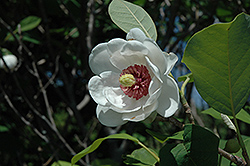* This is a "special order" plant - contact store for details
Height: 25 feet
Spread: 20 feet
Sunlight:
![]()
![]()
Hardiness Zone: 5b
Other Names: Siebold's Magnolia, Summer Magnolia
Description:
An outstanding variety, displaying multitudes of pure white, cup shaped flowers from early to mid summer, long after most other magnolias; showy bright yellow foliage in fall with unusual and large orange seedheads which split to reveal deep purple seeds
Ornamental Features
Oyama Magnolia features showy fragrant semi-double white cup-shaped flowers with burgundy eyes held atop the branches from early to mid summer. It has dark green deciduous foliage. The pointy leaves turn yellow in fall. The fruits are showy orange pods displayed in early fall.
Landscape Attributes
Oyama Magnolia is a multi-stemmed deciduous tree with a more or less rounded form. Its average texture blends into the landscape, but can be balanced by one or two finer or coarser trees or shrubs for an effective composition.
This is a relatively low maintenance tree, and should only be pruned after flowering to avoid removing any of the current season's flowers. Deer don't particularly care for this plant and will usually leave it alone in favor of tastier treats. It has no significant negative characteristics.
Oyama Magnolia is recommended for the following landscape applications;
- Accent
- General Garden Use
Planting & Growing
Oyama Magnolia will grow to be about 25 feet tall at maturity, with a spread of 20 feet. It has a low canopy with a typical clearance of 2 feet from the ground, and is suitable for planting under power lines. It grows at a medium rate, and under ideal conditions can be expected to live for 60 years or more.
This tree does best in full sun to partial shade. It requires an evenly moist well-drained soil for optimal growth, but will die in standing water. It is not particular as to soil type, but has a definite preference for acidic soils, and is subject to chlorosis (yellowing) of the foliage in alkaline soils. It is quite intolerant of urban pollution, therefore inner city or urban streetside plantings are best avoided, and will benefit from being planted in a relatively sheltered location. Consider applying a thick mulch around the root zone in winter to protect it in exposed locations or colder microclimates. This species is not originally from North America.
* This is a "special order" plant - contact store for details

